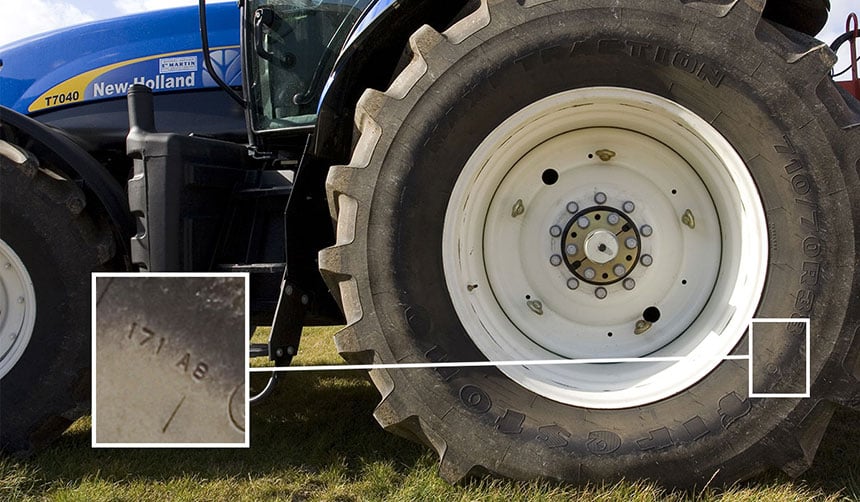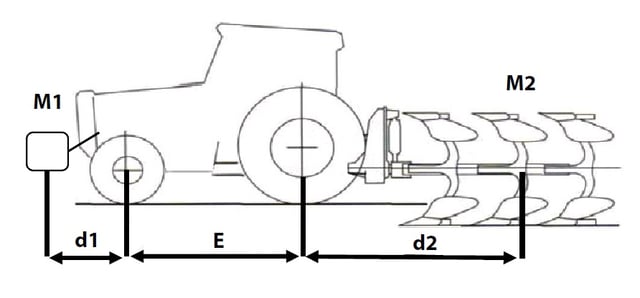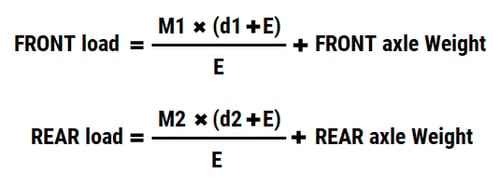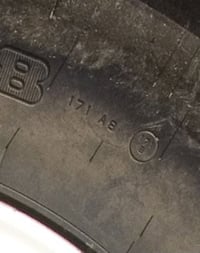How do you accurately calculate the maximum weight your tractor tyres can support? How do you work out how much load is transferred from the tool to the front and rear axles? How can you make sure you don't exceed the maximum load your tyres can handle? What weight should you put in the front to offset the weight of the tool behind, without exceeding the load limit for your tyres? What type of tyre is easiest in terms of pressure management? These are all questions you should be asking yourself if you want to avoid ruining your tyres in the space of a few months.

Your tyres' load index is extremely important in deciding which tools you can use with your tractor or how you can load your trailers. If you already know the weight of your tools and you can calculate the load transferred to the tractor axles, you can go ahead and buy the right type of tyres for the work you carry out most often.
We all have a tendency to load our trailers to maximum capacity during our daily work, to quickly calculate the load transfer based on the tool, and to not bother adjusting the tyre pressure between the road and the field because it takes up too much time.
But remember, if the pressure is not adjusted it can lead to rapid tyre wear and will cost you a lot of money, as you'd have to replace your tyres more often and the quality of your work would be affected (vibrations, slip, soil compaction), but not heeding the maximum load per tyre can lead to accidents that cost you even more dearly.

If you don't have any weighing equipment, you can calculate the load on each axle to make sure you're using the right pressure and that your tyres are protected.
| 1 | Your tractor's tare weight: read the manufacturer's information to find the front axle tare weight (FA tw) and the rear axle tare weight (RA tw). |
| 2 | The weight of the rear-mounted tool M2(manufacturer data). |
| 3 | The front ballast weight M1(or front-mounted tool, where applicable). |
| 1 | The distance d1between the centre-point of the front ballast weight (or centre-point of the front-mounted tool) and the centre of the front axle. |
| 2 | The distance E between the centre of the front axle and the centre of the rear axle. |
| 3 | The distance d2 between the centre of the rear axle and the centre-point of the rear-mounted tool. |


In the table below you can find the load index that matches the marking on your tractor tyre.
This index tells you the maximum weight your tyre can bear at a given speed.
The tyre load index (LI) given in the table above is only valid if you stay below the speed code stated in the table below. In the photos for example, "171 A8" only applies to this agricultural tyre if you drive no faster than 40 km/h. Anything over this speed and your tyre will be overloaded, and will wear down very quickly and may even be extremely dangerous at higher speeds.
| I.C. | kg | I.C. | kg | I.C. | kg | I.C. | kg | I.C. | kg |
| 73 | 365 | 74 | 375 | 75 | 387 | 76 | 400 | 77 | 412 |
| 78 | 425 | 79 | 437 | 80 | 450 | 81 | 462 | 82 | 475 |
| 83 | 487 | 84 | 500 | 85 | 515 | 86 | 530 | 87 | 545 |
| 88 | 560 | 89 | 580 | 90 | 600 | 91 | 615 | 92 | 630 |
| 93 | 650 | 94 | 670 | 95 | 690 | 96 | 710 | 97 | 730 |
| 98 | 750 | 99 | 775 | 100 | 800 | 101 | 825 | 102 | 850 |
| 103 | 875 | 104 | 900 | 105 | 925 | 106 | 950 | 107 | 975 |
| 108 | 1 000 | 109 | 1 030 | 110 | 1060 | 111 | 1 090 | 112 | 1 120 |
| 113 | 1 150 | 114 | 1 180 | 115 | 1215 | 116 | 1 250 | 117 | 1 285 |
| 118 | 1 320 | 119 | 1 360 | 120 | 1 400 | 121 | 1 450 | 122 | 1 500 |
| 123 | 1 550 | 124 | 1 600 | 125 | 1 650 | 126 | 1 700 | 127 | 1 750 |
| 128 | 1 800 | 129 | 1 850 | 130 | 1 900 | 131 | 1 950 | 132 | 2 000 |
| 133 | 2 060 | 134 | 2 120 | 135 | 2 180 | 136 | 2 240 | 137 | 2 300 |
| 138 | 2 360 | 139 | 2 430 | 140 | 2 500 | 141 | 2 575 | 142 | 2 650 |
| 143 | 2 725 | 144 | 2 800 | 145 | 2 900 | 146 | 3 000 | 147 | 3 075 |
| 148 | 3 150 | 149 | 3 250 | 150 | 3 350 | 151 | 3 450 | 152 | 3 550 |
| 153 | 3650 | 154 | 3 750 | 155 | 3 875 | 156 | 4 000 | 157 | 4 125 |
| 158 | 4 250 | 159 | 4 375 | 160 | 4 500 | 161 | 4 625 | 162 | 4 750 |
| 163 | 4 875 | 164 | 5 000 | 165 | 5 150 | 166 | 5 300 | 167 | 5 450 |
| 168 | 5 600 | 169 | 5 800 | 170 | 6 000 | 171 | 6 150 | 172 | 6 300 |
| 173 | 6 500 | 174 | 6 700 | 175 | 6 900 | 176 | 7 100 | 177 | 7 300 |
| 178 | 7 500 | 179 | 7 750 | 180 | 8 000 | 181 | 8 250 | 182 | 8 500 |
| 183 | 8 750 | 184 | 9 000 | 185 | 9 250 | 186 | 9 500 | 187 | 9 750 |
| 188 | 10 000 | 189 | 10 300 |
| SPEED CODE | SPEED (km/h) | SPEED CODE | SPEED (km/h) | |
| A1 | 5 | B | 50 | |
| A2 | 10 | C | 60 | |
| A3 | 15 | D | 65 | |
| A4 | 20 | E | 70 | |
| A5 | 25 | F | 80 | |
| A6 | 30 | G | 90 | |
| A7 | 35 | |||
| A8 | 40 |
Agricultural tyres made using VF technology are the most efficient low-pressure model on the market, enabling you to carry heavier loads with greater resistance per tyre, increase your tractor's traction capacity, and reduce your fuel consumption.
However, the biggest selling point is their reinforced casing design, which allows them work in fields at a very low pressure (0.8 bar), where the compressed tyres distribute the weight across a greater surface area, preserving your crops and your productivity.
They require no pressure adjustments between roads and fields, and are able to withstand higher road speeds at the same pressure as used in the field, while still offering a comfortable drive.
Although they are more expensive, they have so many benefits that most farmers never go back to their previous models, and tyre manufacturers occasionally finance so you can maintain your cash flow while producing more and better.
To learn more and boost your farm's profits, Bridgestone Agriculture is offering you a free, detailed white paper that explains the essential role your agricultural tyres play in your productivity.
The most people who have read this article have also read the following articles, which are listed below in order of popularity:
This information is intended only to make you aware of the technical and functional aspects of agricultural tires and their use. It does not allow you to make a judgment or a definitive conclusion on a given problem. Only your agricultural tire expert is able to make a technical assessment and take a final decision, case by case.

BRIDGESTONE EUROPE NV/SA
AG Department
Leonardo Da Vincilaan 1
1930 Zaventem | Belgium
Our regional office:
Athena Drive, Tachbrook Park
Warwick CV34 6UX
United Kingdom